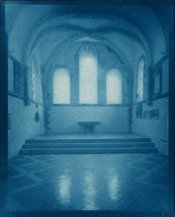Lukas, having read your post I have just pulled my copy of Sprits of Salts off the shelf. Whilst the standard of reproduction isnt the best, it is a book I would recommend as an introduction to alternative processes, including cyanotype. It doesnt go into the process in any depth but does a good job of explaining the basics, I do feel that following the advice contained one should be able to produce a satisfactory cyanotype.
Before anything else, let me just wish all the best for the new year to everybody.
Dave,
well, my reservations are the following: while I might even agree that it gives an introduction into alternative processes, what is the point in succeeding to make any odd print? While I would like to leave all room for artistic freedom, cannot help feeling that, as in artistic photography in general, the main point in using those labour-intensive, troublesome alternative processes today is to create picutres which are really worth the trouble, that is, as, if memory serves, Crawford expressed it, images which turn people's heads - and which provide a rich grammar of personal expression. This is where I think "spirits.." leaves you completely alone.
About the section on cyanotypes: while the necessity of "acid-free" papers is noted (but why only for cyanotypes, as the statement in "disadvantages" on p. 72 implies, and why should this process be printed only on cheap papers?) there is no mention of pre- acidifying, first wash with acidified water (essential with most tap waters for getting deeper blue shadows), or manipulating the colour from cyan to a colder blue, the very recommendable use of Tween 20 for most papers, and I would like to see the effect of just to "wipe of the surplus (of sensitizer) with a piece of cotton wool or a scrap of kitchen roll". (p. 74)
The section on "troubleshooting" (p. 74) is a bit ridiculous, as are the ""further notes on coating the paper" (p. 75), and the section on "Toning" (ibda.)
As for "New Cyanotypes" ("Cyanotype 2", p. 76), the main difference of a longer tonal scale, and the contrast range in general is not mentioned.
All in all, -though this is at least partly a personal impression - the whole chapter implies such an amateurish and dilettantish approach that it makes my hair stand.
Dave, I hope neither you nor anybody else minds my words even if they appear a bit harsh; they are not meant to hurt anybody's feelings, not even of the authors of the book who may be photographers of high standing, but I really cannot help feeling that this book does rather a disservice to the different crafts of alternative printing.







